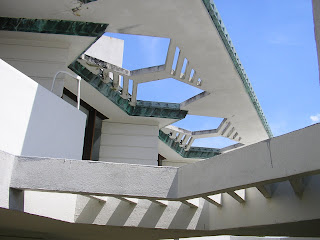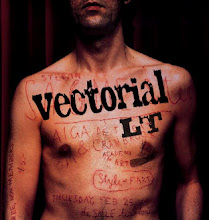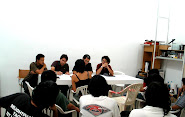
La permanencia de la arquitectura
ENTREVISTA A SOL MADRIDEJOS (ESPAÑA) Y OTAVIO LEONIDIO (BRASIL)
ENTREVISTA A SOL MADRIDEJOS (ESPAÑA) Y OTAVIO LEONIDIO (BRASIL)
Por Gonzalo Galarza Cerf
La española Sol Madridejos y el brasileño Otavio Leonidio están en Lima para escudriñar los proyectos de los alumnos de los últimos ciclos de Arquitectura de la PUCP. Ella, que ha expuesto su obra en bienales como las de Venecia y París y en museos como el MoMA de Nueva York, y él, que ha trabajado con Christian de Portzamparc y ha escrito acuciosos ensayos, trazaron el papel de la arquitectura actual y los errores y a veces horrores que vemos erigidos en el mundo.
¿Se puede forjar actualmente una identidad arquitectónica en un país, en una ciudad?
La española Sol Madridejos y el brasileño Otavio Leonidio están en Lima para escudriñar los proyectos de los alumnos de los últimos ciclos de Arquitectura de la PUCP. Ella, que ha expuesto su obra en bienales como las de Venecia y París y en museos como el MoMA de Nueva York, y él, que ha trabajado con Christian de Portzamparc y ha escrito acuciosos ensayos, trazaron el papel de la arquitectura actual y los errores y a veces horrores que vemos erigidos en el mundo.
¿Se puede forjar actualmente una identidad arquitectónica en un país, en una ciudad?
Sol Madridejos: Sí, ahora la estoy viendo en los proyectos de fines de carrera que están planteados desde los aspectos comunes hasta la historia de la arquitectura y que, sin embargo, tienen una particularidad: tienen respuestas propias a la situación, a la identidad del lugar y del paisaje. Me está sorprendiendo, pues es muy propia del lugar.
¿Es más un aspecto conceptual?
¿Es más un aspecto conceptual?
Porque en ciudades como Bogotá, en un momento dado, los arquitectos empezaron a usar materiales más suyos...
SM: No me interesa tanto la identidad desde un punto de vista formal, eso no es lo fundamental de la arquitectura. Mucho más importante es la respuesta a una realidad y a necesidades. Cuando la arquitectura se independiza de esa realidad y es arquitectura por sí misma, como pasa en Europa (porque esa necesidad es menos perceptible), se convierte en un ícono de sí misma sin dar respuesta a una situación real y pierde realidad.
Es el caso concreto de una obra que pasa a ser un objeto arquitectónico, artístico, como el Museo Guggenheim...
Es el caso concreto de una obra que pasa a ser un objeto arquitectónico, artístico, como el Museo Guggenheim...
SM: Eso tiene valor cuando está bien hecho, en el caso de Bilbao es un proyecto que ha puesto en valor toda la ciudad y que ha sabido adaptarse a los condicionantes del problema que había: desconexiones en una ciudad industrial degradada. Esto se ha sabido resolver por medio del edificio.
Otavio Leonidio: Hay esos casos como Bilbao, pero también hay mucha producción de imágenes y cosas que no son consecuentes. Eso me incomoda mucho, porque no creo que eso contribuya con formar una cultura arquitectónica para mejorar las condiciones de la ciudad.
Es que a veces se salen del rol fundamental de la arquitectura y priorizan más lo artístico.
Otavio Leonidio: Hay esos casos como Bilbao, pero también hay mucha producción de imágenes y cosas que no son consecuentes. Eso me incomoda mucho, porque no creo que eso contribuya con formar una cultura arquitectónica para mejorar las condiciones de la ciudad.
Es que a veces se salen del rol fundamental de la arquitectura y priorizan más lo artístico.
SM: Muchas veces son más objetos de consumo. En España pasa mucho: cualquier alcalde de una ciudad pequeña quiere tener una pieza de un arquitecto estrella aunque no sirva para nada ni tenga un uso, ni una función interior; es simplemente un objeto de consumo muy seductor para el público en un determinado momento. Pero el año que viene estará pasada de moda, hay que buscar la siguiente y pierde una cualidad esencial de la arquitectura: la permanencia. La arquitectura debe ser hecha para permanecer, no solo por la calidad de los materiales, sino también por sus características propias.
Ustedes tienen que lidiar con caprichos de políticos y a veces se cometen horrores.
Ustedes tienen que lidiar con caprichos de políticos y a veces se cometen horrores.
OL: Lo público tiene que ser una expresión de la sociedad y de su voluntad, pero también de la voluntad política. Uno de los problemas es la manutención: se puede tener un espacio muy bonito pero no sirve de nada si un año después es totalmente abandonado.
¿Y cómo se puede lidiar con el mal gusto de ciertos clientes o con las constructoras que buscan mucho la rentabilidad?
¿Y cómo se puede lidiar con el mal gusto de ciertos clientes o con las constructoras que buscan mucho la rentabilidad?
SM: Siempre es una lucha. Para hacer una buena obra arquitectónica hace falta un buen cliente, pero las condiciones ideales no siempre se dan y muchas veces perdemos el 80% del tiempo para defender y sacar adelante un proyecto. El arquitecto es el único que quiere que salga bien, pues ni al cliente, ni al político, ni al constructor les importa... Ellos quieren construir algo rentable. Tampoco es que quieran hacer las cosas mal, simplemente les da lo mismo. Si el arquitecto lo hace bien, es un valor añadido que le da, pero nadie lo pide; es un acto de generosidad, hay que trabajar mucho más para conseguirlo.
OL: Hay un problema de interpretación de la función del arquitecto. No se trata de crear formas impresionantes o bonitas, sino de ayudar a definir los términos de una construcción.
¿Pero retroalimentándose con las artes plásticas continuamente?
OL: Hay un problema de interpretación de la función del arquitecto. No se trata de crear formas impresionantes o bonitas, sino de ayudar a definir los términos de una construcción.
¿Pero retroalimentándose con las artes plásticas continuamente?
SM: Sí, es fundamental entender qué es lo que se plantea en otros ámbitos y llevarlo con los medios de la arquitectura, porque la arquitectura es muy lenta y no se puede hacer un edificio y luego otro e ir probando cosas. Cuando se hace un edificio es uno, es definitivo y dura muchos años.
OL: Yo pertenezco a una tradición de la arquitectura moderna que intenta interpretarla en términos contemporáneos: no existe sin la discusión de las vanguardias artísticas de los siglos XIX y XX, no hay Le Corbusier sin Picasso. No existe la arquitectura moderna sin la investigación espacial pictórica. Es un diálogo muy productivo y no podemos olvidarlo más.
OL: Yo pertenezco a una tradición de la arquitectura moderna que intenta interpretarla en términos contemporáneos: no existe sin la discusión de las vanguardias artísticas de los siglos XIX y XX, no hay Le Corbusier sin Picasso. No existe la arquitectura moderna sin la investigación espacial pictórica. Es un diálogo muy productivo y no podemos olvidarlo más.
Fuente Diario El Comercio




















































